Japan is not only known for its heavenly Ramen and Sushi, but also for the famous Gyoza. In some parts of the world, they are also known as “potstickers”. Making these Japanese potstickers crispy golden brown on the outside and super juicy inside is quite easy and of course way better than take away!! Read on to learn all the secrets of cooking the perfect Gyoza.
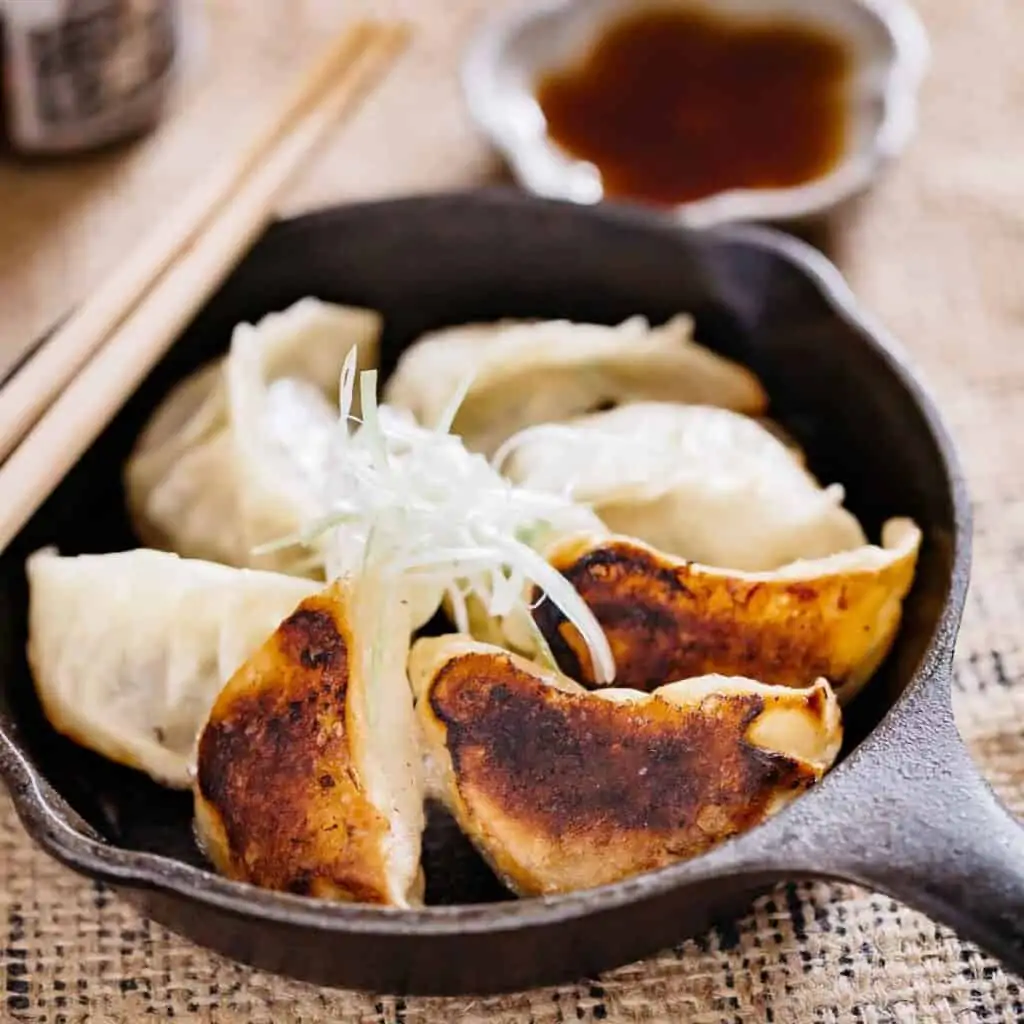
What is Gyoza?
Gyoza is a dumpling filled with ground meat and vegetables wrapped with a thin skin. 饺子 (jiǎo zi; the original Chinese word for Gyoza 餃子) was adopted to Japanese cuisine from Manchuria which is in northern China.
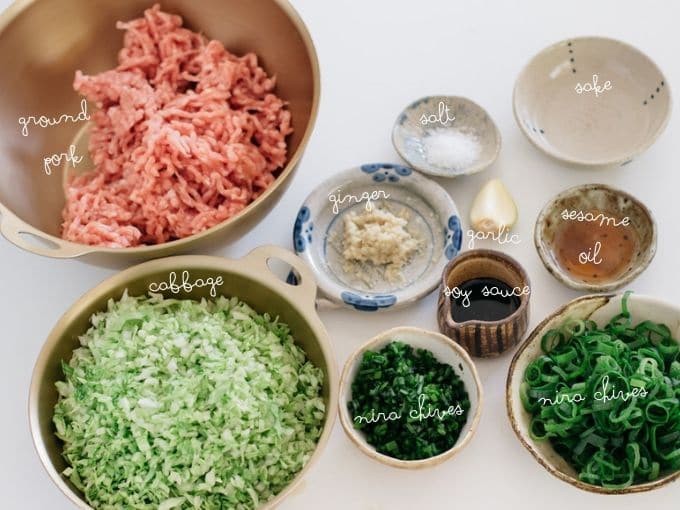
Difference Between Gyoza & Jiaozi
Japanese wrapper is thinner than Jiaozi and the fillings are also cut finer as well. Furthermore, when the Japanese say Gyoza, it generally refers to the pan-fried Yaki Gyoza, whereas Jiaozi is usually boiled. The Japanese version is categorised into four types depending on how they are cooked; Yaki Gyoza (pan-fried), Sui Gyoza (boiled), Mushi Gyoza (steamed), and Age Gyoza (deep-fried).
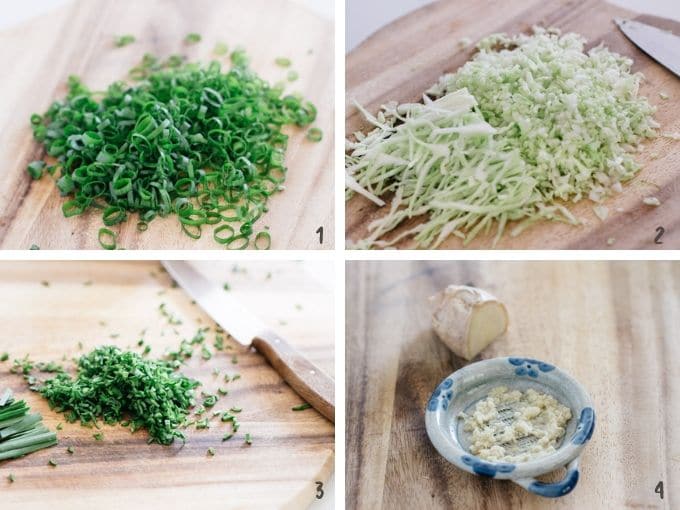
Gyoza Fillings
Ground pork and Cabbage or Wombok are traditionally the main ingredients, but if you decide to use different ingredients, the name will change too! For example, they can be also be called Ebi Gyoza (for shrimp), or Yasai Gyoza (for vegetables). The recipe I am going to share is the basic one that Japanese people usually make, with the main ingredient being ground pork.
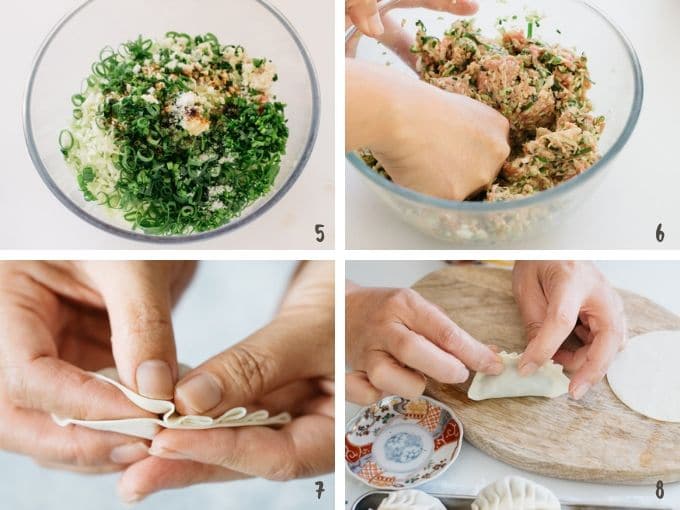
Cabbage vs Wombok (Hakusai)
Which should be the next main ingredient? Cabbage or Wombok (Hakusai)? There is always a debate about whether cabbage or Wombok should be used. I used Cabbage this time because it is now nearly summer and Wombok is out of season. In my opinion, it all comes down to the freshness and availability of the ingredients, as well as peoples’ personal preferences.
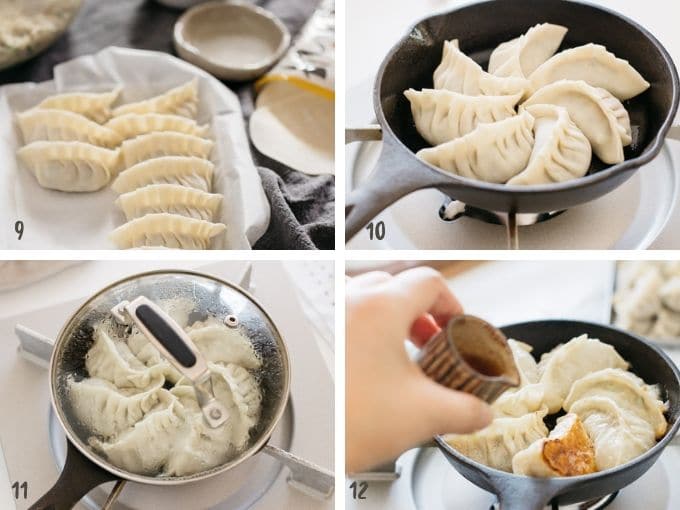
Nira Chive (Chinese chive)
A few months ago, a Japanese friend in my neighbourhood (lucky me) gave me some Chinese chive also known as garlic chives seedlings (Nira in Japanese). Since this plant has grown so well, I decided to use some Nira in my recipe as well. Using Chinese chives or garlic and ginger is a way to clear the unpleasant meat smell that may linger. If you can not access to Nira, substitute with chives.
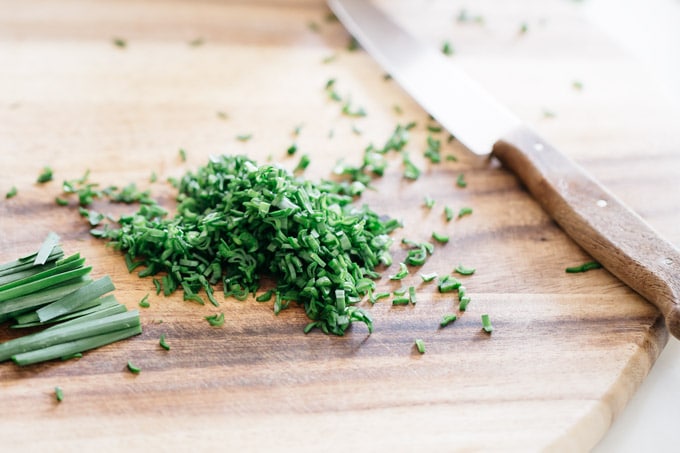
Gyoza Wrapper
As I mentioned above, the Japanese potsticker’s skin is thinner. But where do I get the pre-fabricated wrapper from? I get them from local Japanese grocery stores. Chinese wonton wrappers are readily available from supermarkets, however, I found they are thicker and chewy. I recommend getting Japanese wrappers if possible. They are sold frozen, so thaw them in the fridge before use. Also, you can make your own homemade wrapper easily.
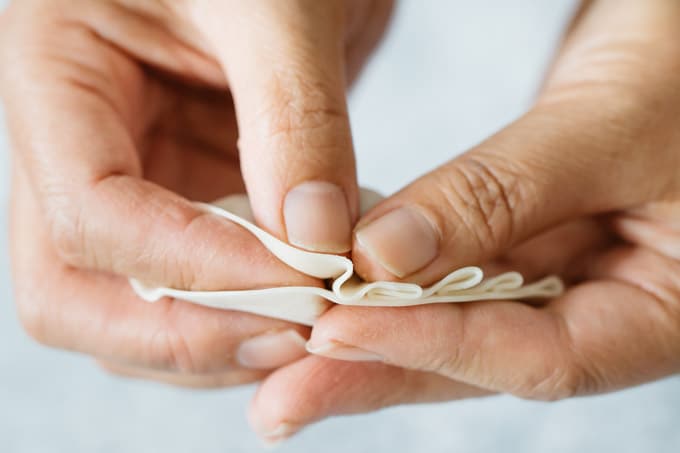
How Thin Should Gyoza Wrappers Be?
In order to make them with a crispy golden brown bottom and juicy inside, the wrappers should be about 0.04 inch (1mm). If you are making from scratch following my recipe, roll out the dough as thin as you can close to 0.04inch or if you buy from shops and if it is thick, roll them out thinner using a rolling pin.
How to Achieve the Crispy Golden Brown Bottom?
Equipment
Professionals use a Gyoza pan which is iron and the thickness of the iron is between 0.15 – 0.2 inch (4-6mm). However, it is not practical for us to have a special pan just to cook Gyoza perfectly at home. I recommend using a cast-iron skillet at home instead.
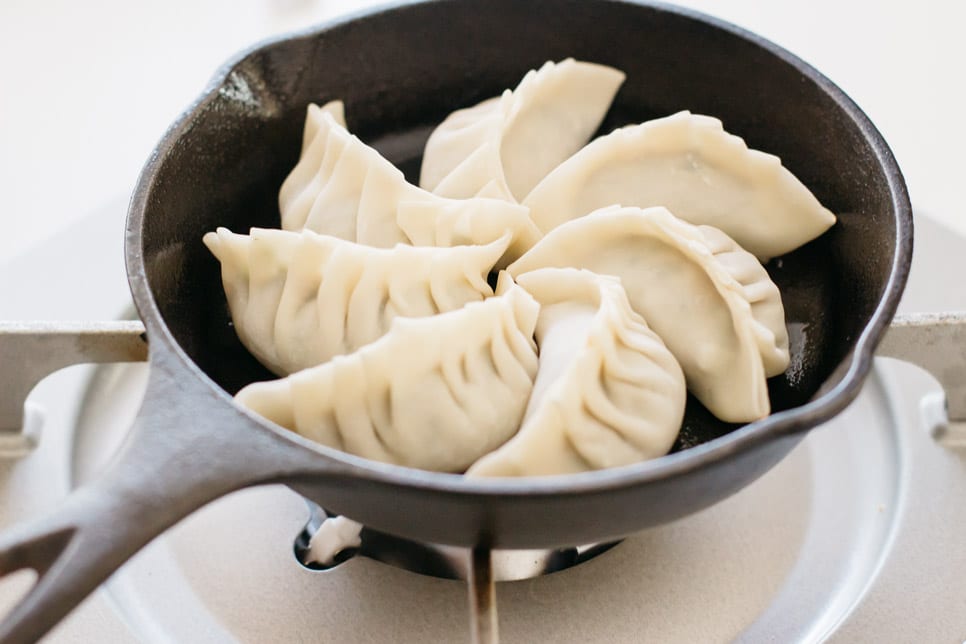
The reason an iron skillet is best to cook potstickers is that the oil penetrates through the skillet surface evenly without repelling the oil, unlike a non-stick frying pan. As a result, this gives the Gyoza bottom an even crispy golden brown. Also, the heat is evenly transferred therefore cooking all dumplings evenly.
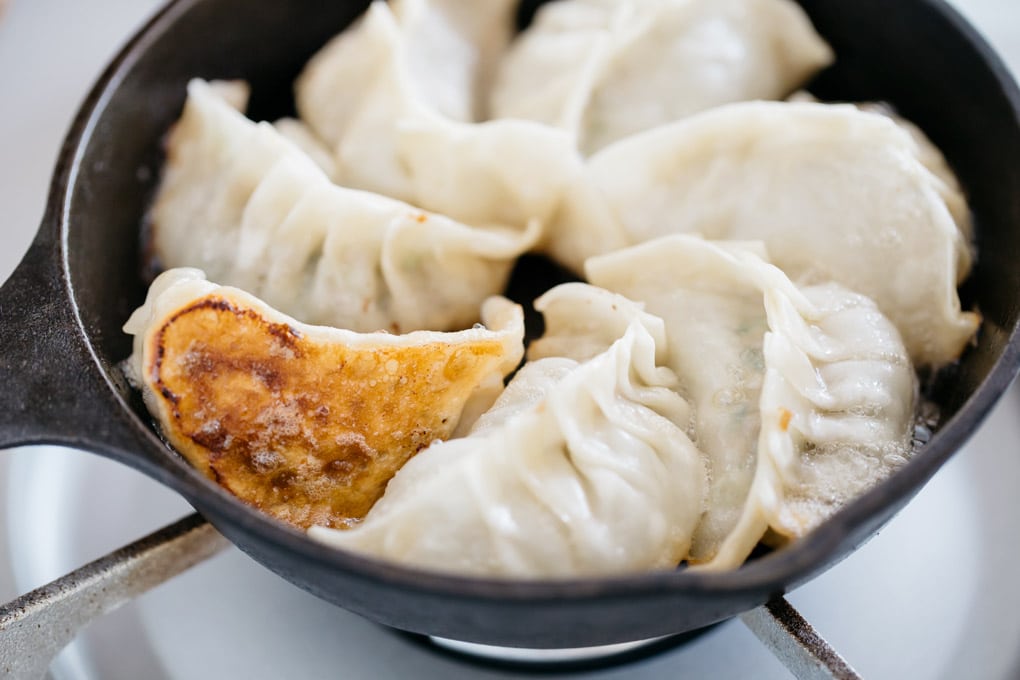
I have a cast-iron skillet (lodge brand) and its thickness is about 3mm (0.12 inch). If the frying pan used is thin, the frying pan will be heated unevenly, according to where the flame hits and where it does not.
Moreover, thick cast iron accumulates heat well and once the skillet is heated, you can cook with very low to medium heat. This results in a crispy outside and juicy inside as the low -medium heat gently cooks inside.
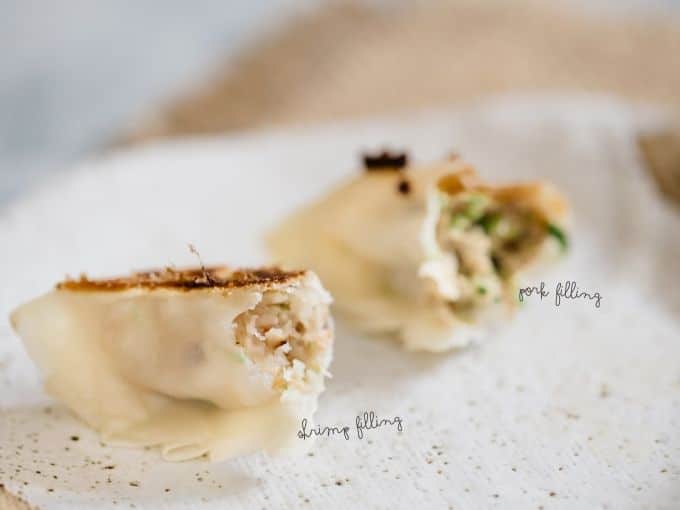
I sometimes use an electrical cooking plate because a whole bunch of Gyoza can be cooked at once, and it makes it easy to control the temperature too. When we had them in Japan, we always used a cooking plate and cooked it out on the table, just like when we would have Teppanyaki or Sukiyaki.
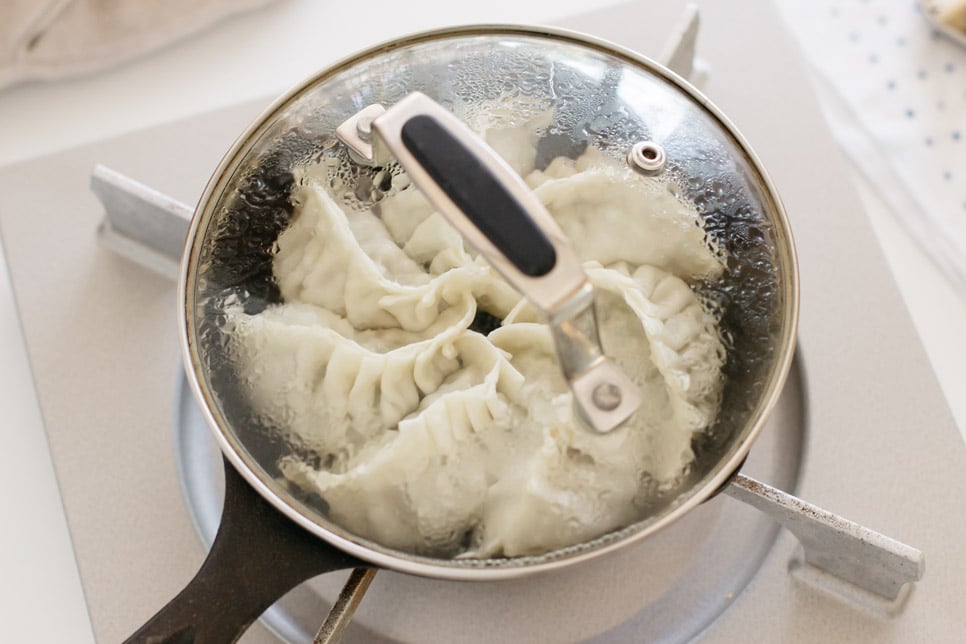
Technique “Steam fried”
Usually, Japanese Gyoza is cooked in a “steam fried” fashion, where it is first fried then steamed to finish them off. When using this method, the water needs to be very hot because if you add cold water it will bring down the pan’s temperature. This will make the wrapper absorb the water, and you will simply end up with a soggy mess, instead of a beautifully cooked crispy dumpling.
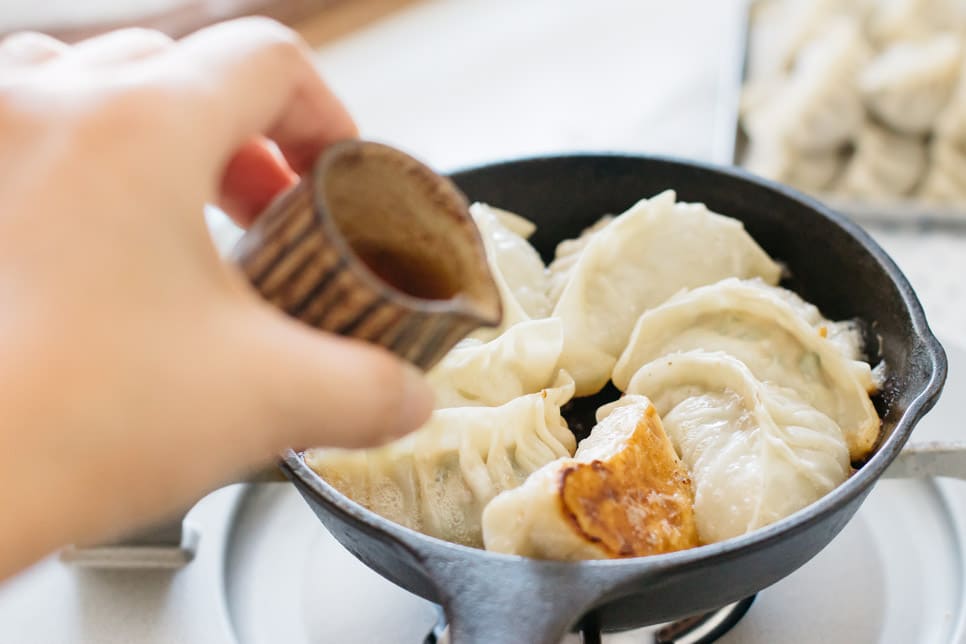
When the water evaporates entirely, and the wrapper becomes transparent, add a little bit of sesame oil for flavour and to make the bottom of the dumpling crispy golden brown. If you add corn starch or plain flour and water mixture, you can make Hanetsuki Gyoza (a recipe that I shared with you previously). Make sure you serve them immediately.
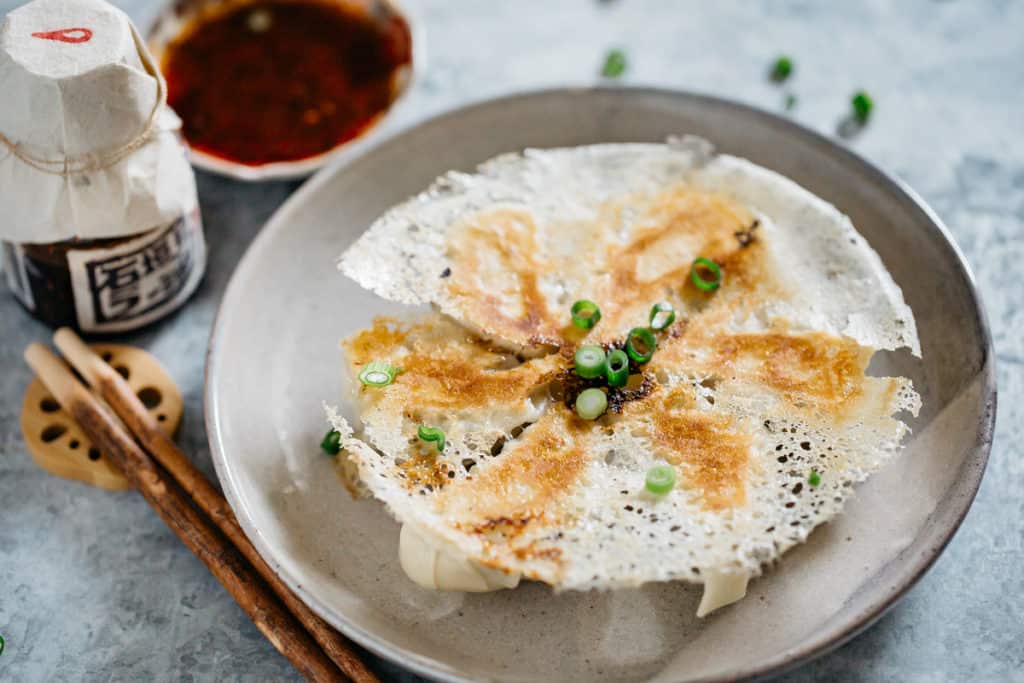
Dipping Sauce
Most Japanese eat these potstickers with the following sauces:
- Soy sauce only
- Soy sauce + rice vinegar
- Soy sauce + chilli oil called Rayi
- Soy sauce + rice vinegar + chilli oil
The golden ratio used in those sauces is five: four: one. For example, five teaspoons soy sauce, to four teaspoons of rice vinegar, to one teaspoon of rayu chilli oil.
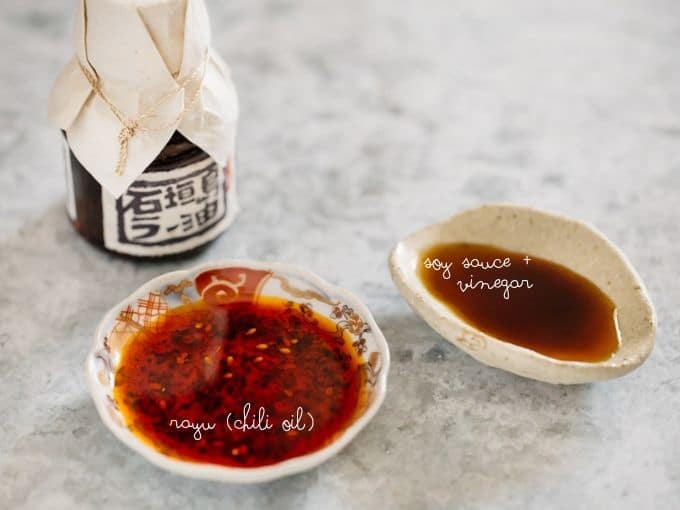
How To Serve?
It is best served immediately with a bowl of plain steamed Japanese rice. It is also served with Shoyu ramen and Shio Ramen as a side dish. I often serve with “Shiraganegi“, which is what we call the white part of green shallots, but they are cut in such a way so as to resemble fine strands of grey hair.
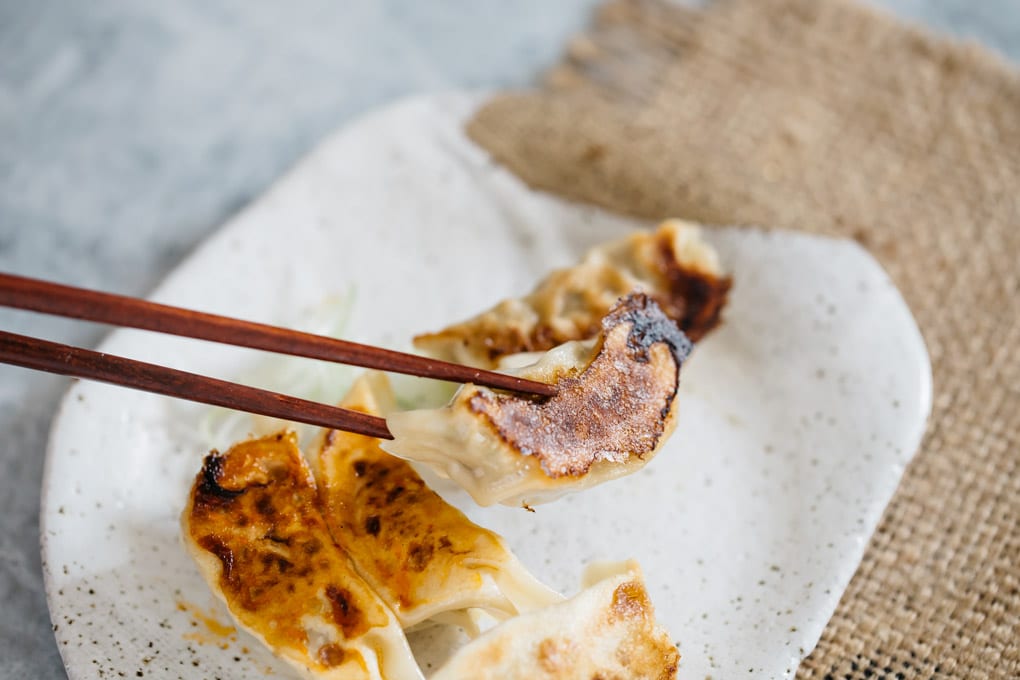
Freezer Friendly
If you have any leftover or want to make a larger batch and keep them for later, freeze them individually then place them in a freezer bag. Stored in the freezer, they will keep for about a month. You can keep the wrappers the same way too. Place parchment paper in between and keep them in a freezer ziplock bag. It will keep about a month in the freezer. Cook frozen on low heat, and steam cook as the same way as cooking them freshly made.
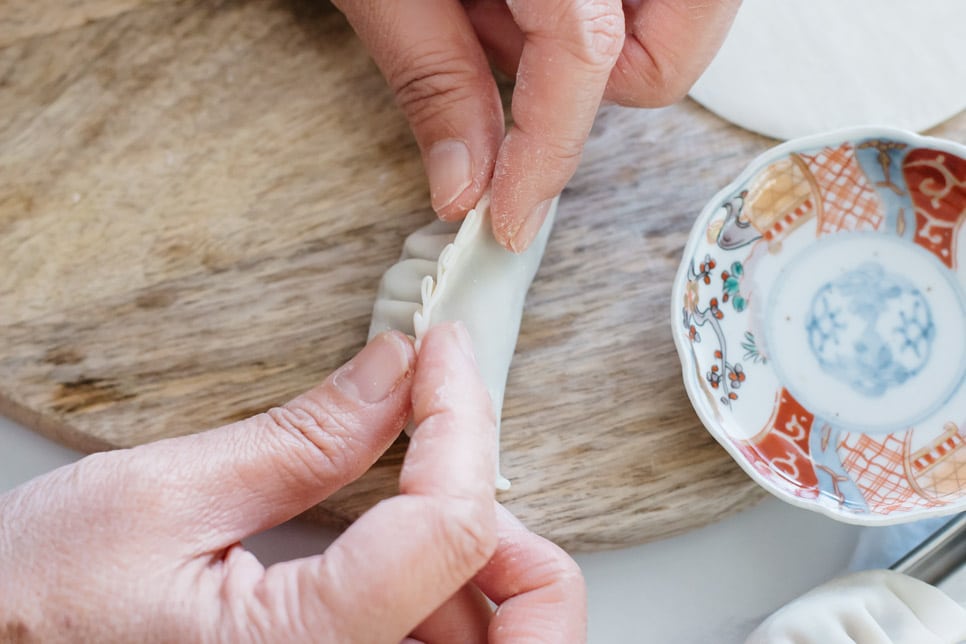
Variations of Gyoza
As I have mentioned above, there are many different types depending on how they are cooked. Check out Gyoza soup, Gyoza rose, Crispy lattice coating gyoza, and Deep-fried gyoza.
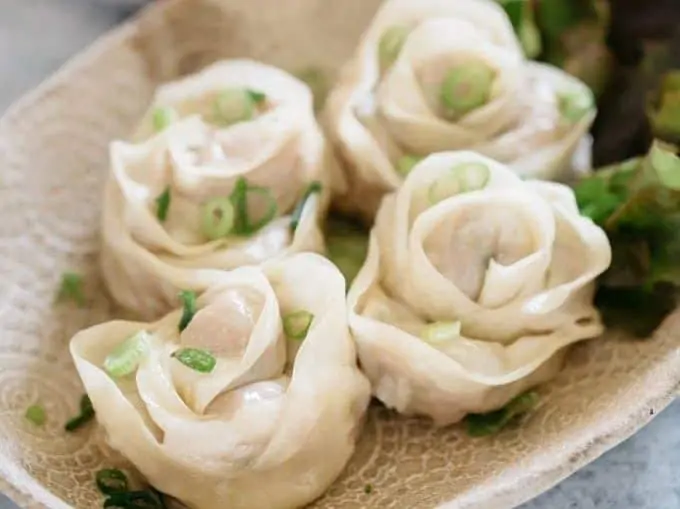
FAQ
A: No, Gyoza wrappers contain gluten, so if you need to make gluten-free, you can make the wrappers from scratch using gluten-free flour.
A: The wrappers are vegan, but the fillings are usually not. So if you would like to make it vegan, choose vegan-friendly filling ingredients.
A: They do not contain any milk or dairy ingredients.
A: No, this recipe does not contain peanuts.
Stay connected
If you like the recipe please rate the recipe and leave comments below. Also don’t forget to follow me on Youtube, Pinterest, Facebook, Twitter and Instagram. This way you keep up to date with all the latest happenings on Chopstick Chronicles. Don’t forget to Sign up for a weekly newsletter so you never miss out on new authentic delicious Japanese recipes! Sign up form is on the right-hand sidebar.
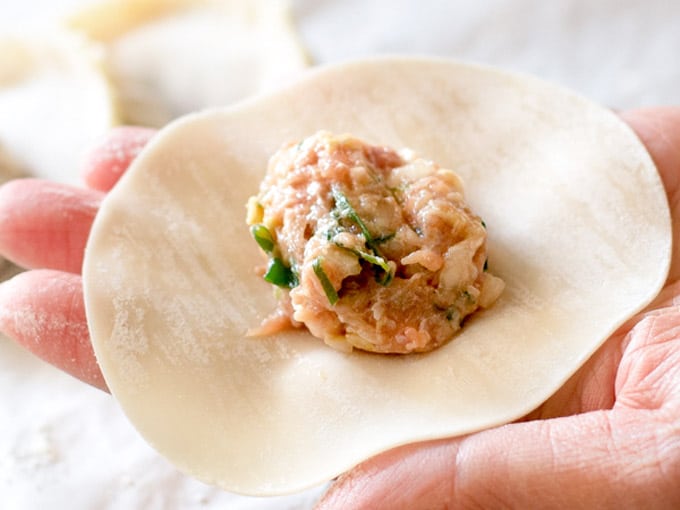
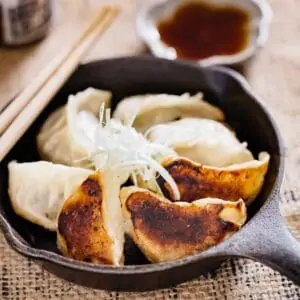
Japanese Gyoza
Ingredients
- 32 Gyoza wrappers I used store bought
- 250 g Pork mince
- 200 g or 2 cups Cabbage
- 20 g or ¼ cup Chinese Chives
- 20 g or ¼ cup Spring onion
- 10 g or ½ tbsp. Grated ginger
- 1 Clove 5g or 1 tsp Garlic
- 1 tbsp Sake
- 1 tbsp Sesame seed oil
- 1 tsp Soy sauce
- 1 tsp Salt
- 1 tbsp vegetable oil for frying
Instructions
- Chop cabbage, Chinese chives, and spring onion finely and set aside.
- Remove the skin from the ginger and grate finely.
- Using a garlic mincer, mince the garlic and set aside.
- Mix the pork mince, shredded cabbage, spring onion, ginger, garlic, soy sauce, sake, sesame oil, salt and pepper together in a bowl.
- Mix together well until they become well combined and sticky in texture.
- Spoon about a tablespoon of the mixture into the centre of a Gyoza wrapper and fold while pinching the sides together to close the Gyoza. Use your thumbs to fold it and use your right index finger to push mince filling in (see photo or mini video if you are not familiar with this method) .
- Heat a frying pan over medium heat and place the Gyoza in the pan and brown the bottom part of the Gyoza.
- Once the Gyoza is slightly browned on the bottom, pour ¼ cup hot water into the pan to steam fry the Gyoza.
- Put a lid on the pan to steam the Gyoza and turn the heat up to high. Steam cook for about 3 minutes.
- Take the lid off and let the water evaporate. Carefully pour a little bit of sesame seed oil around the Gyoza to make the bottom turn crisp and golden brown.
- Turn off the heat and serve the Gyoza on a plate with the bottom up for best presentation.
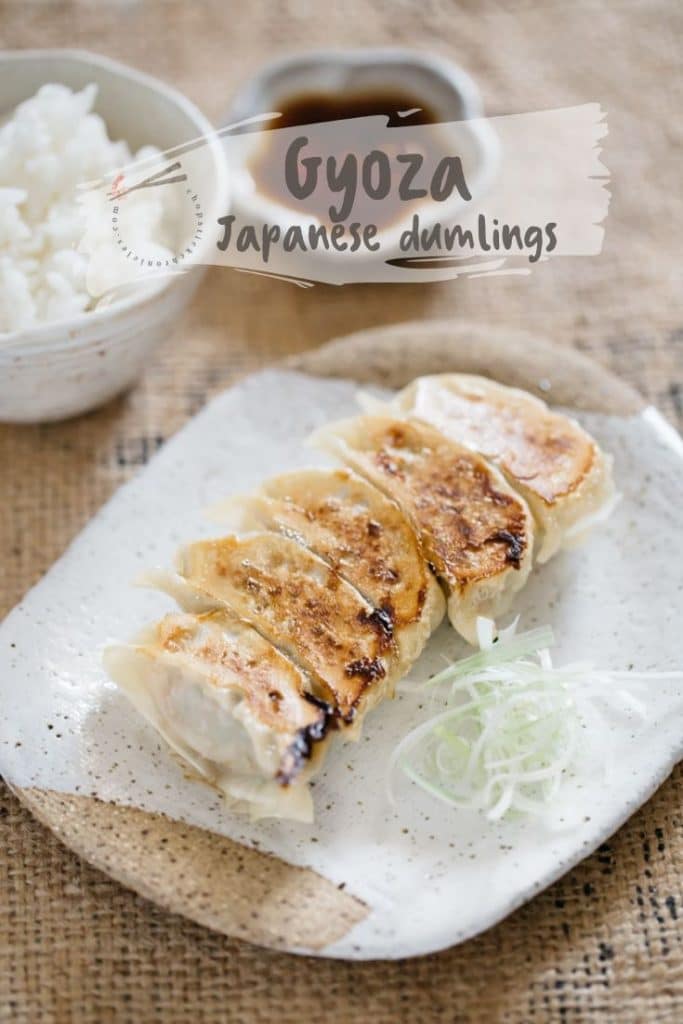
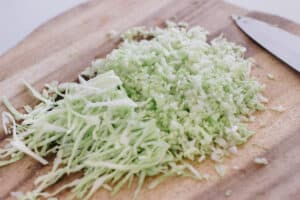
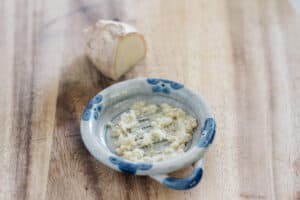
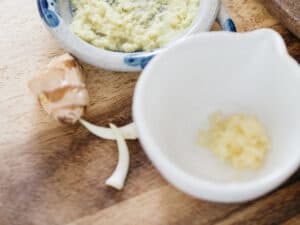
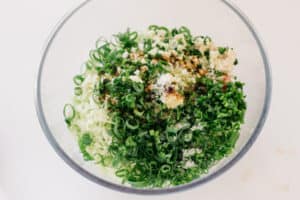
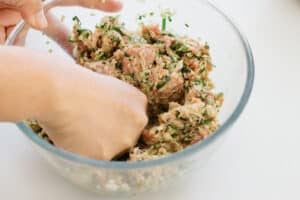
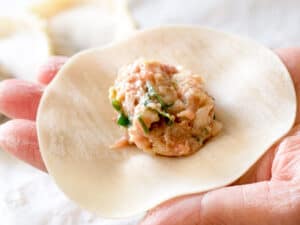
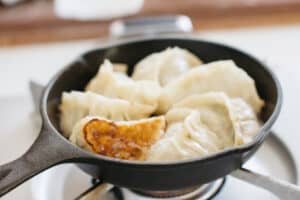
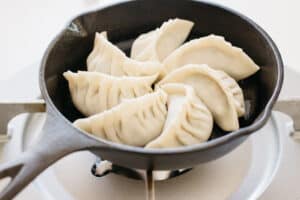
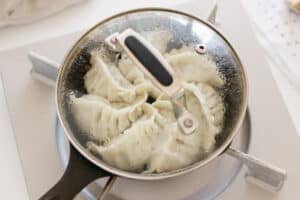
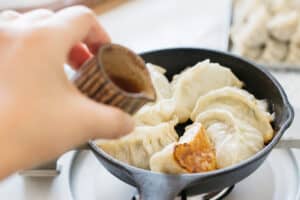
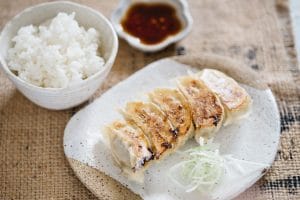
I lived in Japan for a year – this is fried dumpling not fried gyoza – fried gyoza is highly spiced meat (no veggie) in a square wrapper pinched closed with points up like a flower and deep fried. I ate them from Tokyo to Hokkaido, in resterants and Japanese homes and all were just as I described. If you wanted Veggies in a wrapper you had to order fried dumpling.
Hi Lura, I am sorry but I am very confused about your comment. If this is not Gyoza, I am not sure what food you are describing 😵💫
Hi Shihoko,
What an incredible and detailed recipe for Gyoza! I found your recipe when researching what to serve with Gyoza
Thank you for the detailed Authentic Gyoza recipe.
Bill
Thank you Bill 😀
My favorite recipe. It’s fool proof!! Thank you thank you for sharing your techniques.
Good Day Shihoko senpai!
You know what? I tried this dish based on your guidance for so many times and I love its authenticity when it comes to the taste. I saw your website on a youtuber named “Marion’s Kitchen” and I find it very helpful since I’m a huge fan of Japanese dishes. The ingredients are easy to find in the market (except for the Sake I bought in online store).
Thanks and more powers!
You are welcome Jason 😀 Thank you for the great rating and leaving the lovely comment 😀 I am glad you found my blog.
こんにちわしほこさん、私の名前はティベリウです。 どうぞよろしくおねがいします。
I finished preparing the dish a few hours ago, it was a success. ( well according to my wife)
I also prepared your gyoza wrappers recipe, it also came out great. One of the difficulties I encountered was finding the correct flour since in my country flour is ranked a bit differently.
Long story short, good recipes, it was fun preparing them.
Wish you all the best.
ありがとう ティベリウさん。
Hi Shihoko san, I tried your recipe and it was very fun to make and turned out great! The pork came out a little bit dry though and I’m wondering if there is any suggestion on how to help with that. Thank you!
Hi Rudy, add 1/2 to 1 tbsp katakuriko(potato starch) to the pork.